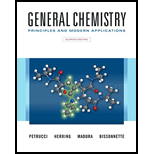
Concept explainers
What formulas would you expect for the metal carbonyls of (a) molybdenum, (b) osmium, (c) rhenium?
Note that the simple carbonyls shown in Figure 23-15 have one metal atom per molecule Some metal carbonyls are binuclear that is, they have two metal atoms bonded together in the carbonyl structure Also, (d) explain why iron and nickel carbonyl are liquids at room temperature, whereas that of cobalt is a solid, and (e) describe the probable nature of the bonding in the compound Na[V(CO)6].
Learn your wayIncludes step-by-step video

Chapter 23 Solutions
General Chemistry: Principles And Modern Applications Plus Mastering Chemistry With Pearson Etext -- Access Card Package (11th Edition)
Additional Science Textbook Solutions
Chemistry: Structure and Properties (2nd Edition)
Chemistry: The Central Science (14th Edition)
Inorganic Chemistry
Introductory Chemistry (6th Edition)
- Please do short explaination the Lanthanide Contraction phenomena along with the example.arrow_forwardHow can O2 interact with a metal as a ligand? Hint: think in terms of sigma and pi bonding motifs. Which orbitals on the metal would interact with which orbitals on the O2?arrow_forwardCompare valid postulated Lewis structures and the VSEPR geometries of the threethe isoelectronic particles: SEE IMAGE What would you say is the relationship between isoelectronic particles, when the number of ligands issame, as in this given series? What happens to the oxidation number of the central atom (A)through this series of particles?arrow_forward
- What causes linkage isomerisation?arrow_forwardDraw the d orbital diagram of the weak and strong field as shown in the pictures. Include the CSFe and uS. (with solution if possible).arrow_forwardType of ligands in Carbonic Anhydrase ? Either monodentate, bidentate, tridentate, tetradentate, tetradentate, hexadentate or else?arrow_forward
- Explain the following observations giving appropriate reasons: (i) The stability of +5 oxidation state decreases down the group in group 15 of the periodic table. (ii) Solid phosphorus pentachloride behaves as an ionic compound. (iii) Halogens are strong oxidizing agents.arrow_forwardDose zinc blende and wurtzite models represent the same structure? Compare andcontrast and the perspectives they have.arrow_forwardGive a brief explanation of this mineral Iron orearrow_forward
- 28a, solve the problem in the picturesarrow_forwardWhat is the chemistry behind the following: a. Rusting occurs rapidly in moist conditions as compared to a dry environment.arrow_forwardIs the following statement true or false? Defend your answer and indicate the importance and action of oxygen in the body. “Oxygen is a ligand”arrow_forward
 Principles of Modern ChemistryChemistryISBN:9781305079113Author:David W. Oxtoby, H. Pat Gillis, Laurie J. ButlerPublisher:Cengage Learning
Principles of Modern ChemistryChemistryISBN:9781305079113Author:David W. Oxtoby, H. Pat Gillis, Laurie J. ButlerPublisher:Cengage Learning
